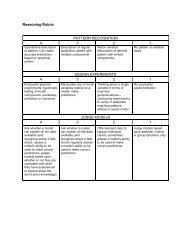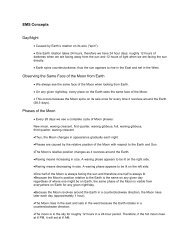Science Education Reform - National Center for Improving Student ...
Science Education Reform - National Center for Improving Student ...
Science Education Reform - National Center for Improving Student ...
You also want an ePaper? Increase the reach of your titles
YUMPU automatically turns print PDFs into web optimized ePapers that Google loves.
TACKLING THE QUESTION<br />
Tackling the Question:<br />
What <strong>Science</strong> Should <strong>Student</strong>s Learn?<br />
INTERVIEW WITH NCISLA ASSOCIATE DIRECTOR RICH LEHRER & COLLABORATING<br />
RESEARCHER LEONA SCHAUBLE, UNIVERSITY OF WISCONSIN–MADISON<br />
Leona Schauble and Rich Lehrer, collaborating<br />
researchers at the University of<br />
Wisconsin–Madison, study the ways<br />
elementary and middle school students<br />
understand and make sense of mathematics<br />
and science. Both also work with the <strong>National</strong><br />
<strong>Center</strong> <strong>for</strong> <strong>Improving</strong> <strong>Student</strong> Learning &<br />
Achievement in Mathematics & <strong>Science</strong>.<br />
L<br />
eona Schauble readily admits<br />
that she and fellow researcher,<br />
Rich Lehrer, don’t consider themselves<br />
to be science re<strong>for</strong>m experts. In fact,<br />
their research is not necessarily considered<br />
to be within the science education<br />
mainstream. However, as<br />
cognitive development and learning researchers,<br />
Schauble and Lehrer have a<br />
unique and valuable perspective to add<br />
to science education re<strong>for</strong>m discussions.<br />
Having worked together at the<br />
Wisconsin <strong>Center</strong> <strong>for</strong> <strong>Education</strong> Research<br />
since 1993, Schauble and<br />
Lehrer have collaborated on innovative<br />
mathematics and science education research<br />
at the elementary and middle<br />
school level. “Like many science education<br />
researchers, we work at the<br />
classroom level,” Lehrer elaborates.<br />
“But we provide another angle on science<br />
education because we come from<br />
a research community that views instruction<br />
from a design perspective. Basically, we begin by questioning traditional<br />
assumptions about what science is worth teaching, especially <strong>for</strong> young<br />
children. We then collaborate with teachers to design classroom instruction that<br />
is sensitive to the resources children can bring to scientific inquiry at different<br />
points of their intellectual development.”<br />
PUTTING MODELING AND MATHEMATICS AT THE<br />
CENTER OF SCIENCE INSTRUCTION<br />
As they discuss traditional education practice, Schauble and Lehrer raise questions<br />
about the way science is typically taught and what is taught. With an eye<br />
on prevalent science curricula, they perceive two fundamental problems with<br />
the way science instruction is conceptualized and carried out in classrooms.<br />
First, in their view traditional science instruction tends to disregard, or worse,<br />
misunderstand the way children develop intellectually or cognitively. Many, perhaps<br />
most, curricula tend to be shaped around scientific disciplines without accounting<br />
<strong>for</strong> the way children think or understand scientific processes and<br />
concepts. Others are based on outmoded conceptions of development that underestimate<br />
children’s capabilities. “For example,” Schauble elaborates, “some<br />
curricula cast first-graders as ‘concrete operational’ in their intellectual processing<br />
and there<strong>for</strong>e unable to engage in complex <strong>for</strong>ms of reasoning. Such curricula<br />
plainly underrate kids’ learning potential.”<br />
(continued . . . )<br />
7





